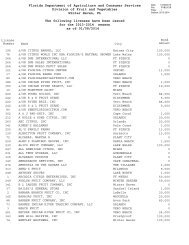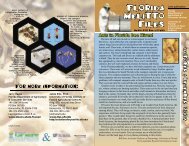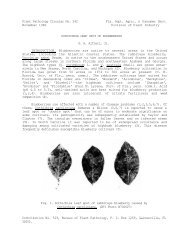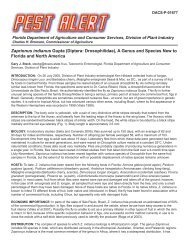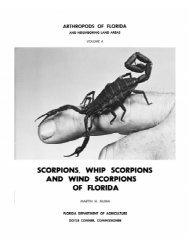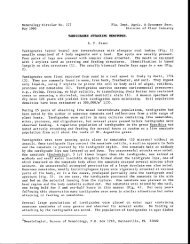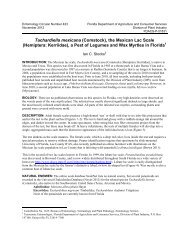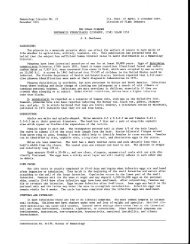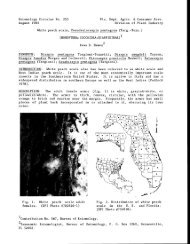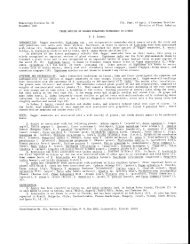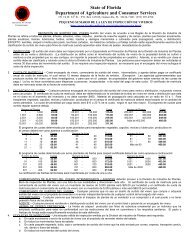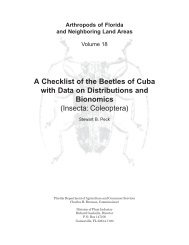Food Safety Audit - Packinghouse - Florida Department of ...
Food Safety Audit - Packinghouse - Florida Department of ...
Food Safety Audit - Packinghouse - Florida Department of ...
You also want an ePaper? Increase the reach of your titles
YUMPU automatically turns print PDFs into web optimized ePapers that Google loves.
FDACS 07085 Rev 05/11<br />
Page 18 <strong>of</strong> 31<br />
FOOD SAFETY AUDIT-TOMATO GOOD AGRICULTURE PRACTICES<br />
PACKINGHOUSE<br />
D. Product Wash Water Management<br />
Item# Requirement Procedure Verification Corrective Action/<br />
7.8 Only sanitizers or sanitizer<br />
systems registered or<br />
approved by EPA or the<br />
prevailing regulatory<br />
agency for their specific<br />
intended use may be used<br />
in the dump tank wash<br />
water, on the spray line or<br />
other food contact<br />
purposes.<br />
7.9 If used as sanitizer in<br />
dump tank or on spray line<br />
chlorine concentration is<br />
monitored to assure the<br />
minimum 150 ppm free<br />
chlorine concentration at<br />
start up and every hour<br />
thereafter. In addition pH<br />
is monitored to be in the<br />
range <strong>of</strong> 6.5 – 7.5 at start<br />
up and every hour<br />
thereafter.<br />
□ C<br />
□ CAN<br />
□ IAR<br />
□ NA<br />
□ C<br />
□ CAN<br />
□ IAR<br />
□ NA<br />
Operation maintains a current list <strong>of</strong><br />
approved products (e.g., sanitizers,<br />
acids, surfactants) that may contact<br />
tomatoes and are approved for food<br />
contact use in the facility.<br />
Operation shall have a procedure<br />
that includes minimum limits for<br />
sanitizer in wash water for food<br />
safety. Non-recirculating spray<br />
systems do not require sanitizer for<br />
food safety. Procedure shall include<br />
how to control, monitor and record<br />
use <strong>of</strong> wash water sanitizer as<br />
needed to assure continuous<br />
compliance with minimum limits.<br />
Operation shall have a procedure as<br />
to what corrective actions are taken<br />
if criteria are not met.<br />
<strong>Audit</strong>or reviews chemical list and<br />
observes inventory <strong>of</strong> water treatment<br />
chemicals for compliance. <strong>Audit</strong>or<br />
reviews labels or other manufacturer<br />
documents that demonstrate sanitizers<br />
being used are registered for the<br />
specific intended use.<br />
<strong>Audit</strong>or shall review the procedure and<br />
shall review records <strong>of</strong> sanitizer use,<br />
verification <strong>of</strong> treatment levels and<br />
monitoring records. <strong>Audit</strong>or reviews<br />
records for deviations and their<br />
disposition.<br />
Disposition<br />
Non-compliances are corrected<br />
on site. Unapproved chemicals<br />
are removed from use and<br />
replaced with approved<br />
chemicals. Procedures are<br />
developed or revised.<br />
Retraining is performed. If<br />
unapproved chemicals are<br />
used, or approved chemicals<br />
are used in an unapproved<br />
manner, operation shall assess<br />
potential for product<br />
adulteration. Tomatoes that<br />
have contacted sanitizer used<br />
in an unapproved manner are<br />
adulterated<br />
.<br />
Procedure is developed or<br />
revised. Retraining is<br />
performed. Tomatoes exposed<br />
to sanitizer in excess <strong>of</strong> label<br />
limits are treated by an<br />
approved method to bring<br />
tomatoes into compliance or<br />
are discarded. Tomatoes<br />
exposed to sanitizer below<br />
established minimum limits<br />
shall be discarded back to the<br />
last evidence <strong>of</strong> compliance.



